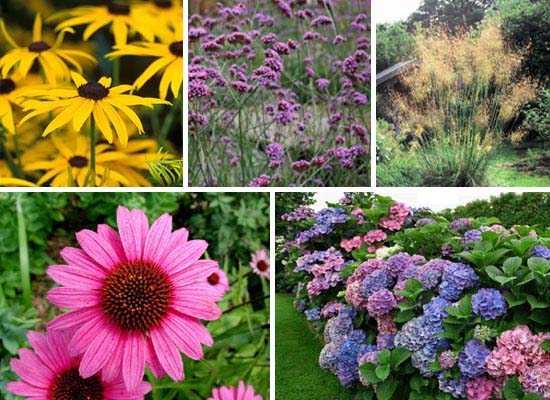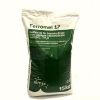August in the Garden (What to Do)
As we move to the end of the Summer, August is a time to tidy beds and borders after the crazy mid Summer's growth. Once thriving and luscious foliage gives way to ageing yellow leaves. The tallest of herbaceous plants begin to bend and fall over while clump forming perennials start growing leggy. All this can give rise to an unkempt look to the garden in the month of August.
Even though the warmest of weather is behind us, August can still offer the best of sunshine and more reliably drier weather. Colour should not be seen as a thing of the past either. There is a long list of wonderful flower plants that will bloom throughout August.
Plants of the Month
From Left to Right
Rudbeckia 'Susan', Verbena bonariensis, Stipa gigantea, Echinacea purpurea, Hydrangea
Things to Consider for August
Even if the Summer is drawing to an end, now is not the time to let up on maintenance as weeds & pests continue to be a problem during the month. Also August can see long dry spells and when this occurs irrigation of vegetables is especially important as harvest nears.
Lawn care is back on the agenda in August and this too is a good month for preparing new lawns. It is however best to avoid applying any sort of Nitrogen based fertiliser to lawns at this time of year.
Things to Do
In the Fruit & Veg Garden
- Cut away the old and yellowing foliage of courgettes, tomatoes, broccoli and all other vegetables to allow for better air circulation
- Twist onion stems in preparation for harvest
- Ensure root crops and tomatoes receive regular watering to avoid split roots & fruits
- Sow seeds for Christmas & Spring harvest. You can sow Spring Cabbage, Winter Cabbage, Kale, Salads, Carrots, Broccoli, Chard, Spinach, Lettuce and Beets
- Continue to feed your plants, focus on using a high potassium based feed on tomatoes, courgettes, fruits & cucumbers
- Keep harvesting all crops little and often. With regularly harvesting you can prevent vegetables from going to seed, crops from going off and you can also encourage a second yield
- If your vegetable plot is becoming bare, by the end of the month you can sow green manure
In the Greenhouse
- Maintain regular watering of crops
- Keep doors & window vents open during the day
- Continue to pinch out side shoots of tomatoes, if tomatoes are too slow to ripen you should sacrifice some fruits for the sake of others
- Slugs, snails and aphids can still be a problem this month
- Make softwood cuttings of Lavender, Geraniums & Fushias and place in compost & perlite
Plant Care
- Support taller herbaceous plants using bamboo canes or stakes
- Trim back leggy flowers such as Geraniums and Asters & Sage
- Continue to treat roses for black spot & mildew. Also dead head regularly
- Remove suckers that sprout from the base of rose plants
- Feed late Summer & autumn Flowering plants such as Verbenas, Dahlias, Echinaceas & Rudbeckias
- Flowering heads of alliums & hydrangea can be left in situ or brought indoors as cut flowers
- Begin collecting seeds of herbaceous & flowering plants. Label and store in a cool, dry place for sowing the following Spring
- Order your spring bulbs for planting at the end of the month
- August is a good month for trimming evergreen and beech hedging
- Divide Irises, Lilies, Dicentra, Hostas, Aubretia, Iberis, Peonies, Primrose and Poppies
Lawn Care
- Avoid feeding lawns from the end of July onwards
- By the end of the month you can begin treatment of moss. Apply Sulphate of Iron to lawns
- Apply dicophar to kill any broadleaf weeds
- Towards the end of the month, in dry conditions you can aerate your lawn
- Scarification can also be done to remove thatch and dead grass and moss from lawns
- Reseed bare patches in the grass and water in after sowing
- Begin preparing areas for new lawns by applying a systemic weed killer
General Maintenance
- Rake up fallen leaves caused by periods of dry weather
- Stay on top of weeds
- Check trees and tree stakes ensuring they are not too tight around stems
- Clean bird baths, feeders & tables and increase feeding times for birds









